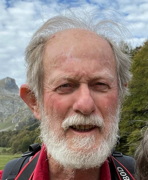Roger Clarke's Web-Site
© Xamax Consultancy Pty Ltd, 1995-2024

Infrastructure
& Privacy
Matilda
Roger Clarke's Web-Site© Xamax Consultancy Pty Ltd, 1995-2024 |

|
|||||
| HOME | eBusiness |
Information Infrastructure |
Dataveillance & Privacy |
Identity Matters | Other Topics | |
| What's New |
Waltzing Matilda | Advanced Site-Search | ||||
Principal, Xamax Consultancy Pty Ltd, Canberra
Visiting Professor, Baker & McKenzie Cyberspace Law & Policy Centre, University of N.S.W.
Visiting Professor, E-Commerce Programme, University of Hong Kong
Visiting Fellow, Department of Computer Science, Australian National University
Version of 7 February 2004, plus insertion of source on 18 February 2004
© Xamax Consultancy Pty Ltd, 2004
This document is at http://www.rogerclarke.com/DV/SmartGate040207.html
Applications of face-recognition technology have been uniformly unsuccessful. Technology providers and security agencies are desperate for some good news.
It's very likely that a project called SmartGate, conducted by the Australian Customs Service, will be trumpeted throughout the world as the good news that face-recognition technology has been waiting for.
This email contains an assessment of the extreme manipulation of data, truth and the media on which such 'good news' stories will be based.
SmartGate is the Australian Customs Service's pilot face-recognition system, using German Cognitec technology. It has been trialled for a year on QANTAS aircrew. The stated intention of the Australian Government is to extend it further. This project is running in parallel with a Passports Office project to change Australian passports to conform with U.S. demands.
Customs have been trying to convince suppliers to finance the development of the scheme. It does not appear that any independent testing has been performed; but a couple of international experts were invited to review the internal test results. A media event was held on Friday 6 Feb 04. The information made available to the public is listed below.
The brazenness of Custom's manipulation of media and public opinion exceeds the standards normally expected of the Government.
(1) No data has been provided, despite assurances given in the past that data would be provided.
(2) The invited experts who were paraded by Customs are arguably about the world's two foremost designers of testing for biometric technologies.
But is appears that:
All that they were permitted to do was explained as follows:
(3) The only report that matters was undertaken by the Defence Science and Technology Organisation (DSTO). There are some serious problems here:
(4) The best quotation that Customs seem to have been able to extract from the two experts was that "the scheme's performance is remarkably good for an operational facial recognition system".
That seems quite positive, until you realise that the other attempts around the world have been abject failures, and pilot after pilot has been quietly abandoned.
In other words, the quotation can be readily interpreted as "it doesn't work very well, but it's better than the other disasters we've seen".
This is borne out by an answer by one of the experts to a reporter's question. He said: "In one test 100 company employees attempted to impersonate someone other than themselves and eight of them were falsely accepted by the system. That is a very low rate of false accepts"**. At that"very low" level of false acceptances, every 747-load of people can include 25-30 terrorists; and some (undeclared) number of people will miss the plane because they were false rejections, and they're still waiting in the queue for interrogation.
** Quotation from 'Airport scanning not quite picture perfect', Sue Lowe, in The Sydney Morning Herald of 7 February 2004, p.3
The Minister had promised that the announcements about the tests would vindicate his claims that the scheme works.
This media event has done two things.
It has confirmed that the Government intends to continue constructively misinforming the public about Smartgate and about biometrics technologies.
And it has, in the process, tarnished the reputations of the two scientists.
(I wasn't invited to the media event, and haven't been provided with any information by Customs. That's fair enough: I'm not a member of the media. But on the other hand I've been much-quoted in the media; and Customs have previously sought meetings with me, and adopted the pretence of wanting to keep me informed).
Customs issued a media release.
This points to one marketing brochure (1 page) and another marketing brochure (2 pages).
No further information was provided.
The unlinkable page reached via:
has had all previous documents withdrawn from it, and the only links available are the two marketing brochures pointed to above.
None of the other 17 hits arising from a search on 'SmartGate' on Customs' web-site appear to be new.
Additional background information is in my paper of mid-2003, including:
Sceptical reports about face-recognition technology, including the authoritative ACLU materials and EPIC's resource-page, are indexed within my Biometrics Bibliography.
| Personalia |
Photographs Presentations Videos |
Access Statistics |
 |
The content and infrastructure for these community service pages are provided by Roger Clarke through his consultancy company, Xamax. From the site's beginnings in August 1994 until February 2009, the infrastructure was provided by the Australian National University. During that time, the site accumulated close to 30 million hits. It passed 65 million in early 2021. Sponsored by the Gallery, Bunhybee Grasslands, the extended Clarke Family, Knights of the Spatchcock and their drummer |
Xamax Consultancy Pty Ltd ACN: 002 360 456 78 Sidaway St, Chapman ACT 2611 AUSTRALIA Tel: +61 2 6288 6916 |
Created: 7 February 2004 - Last Amended: 7 February 2004, plus insertion of source on 18 February 2004 by Roger Clarke - Site Last Verified: 15 February 2009
This document is at www.rogerclarke.com/DV/SmartGate040207.html
Mail to Webmaster - © Xamax Consultancy Pty Ltd, 1995-2022 - Privacy Policy